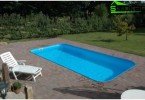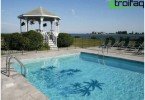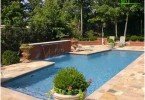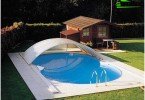Pavilions for pools
The pool pavilion is a light and transparent design that can have a different shape and appearance, due to which it fits perfectly into almost any landscape interior and at the same time does not violate the general harmony and proportion. However, the pavilion performs not only aesthetic functions, but also has a rather important practical purpose:
• Reduces heat loss. The presence of the pavilion significantly reduces the energy consumption for heating the pool;
• Reduces water loss through evaporation;
• Prevents pollution of water from the atmosphere;
• Protects from the effects of weather;
• Refracts direct ultraviolet rays;
• In winter, reduces the likelihood of pool damage;
• Up to 50% saves chemicals needed to maintain water quality;
• Provides bathing safety;
• Extends the swimming season to twelve months a year.
Content
- Types of pavilions for artificial ponds
- Form and types of structures
- DIY pavilion construction
- Pavilion Care
Types of pavilions for artificial ponds
• pavilions for SPA pools;
• combined pavilions;
• high pavilions;
• pavilions of medium height;
• low pavilions for pools.
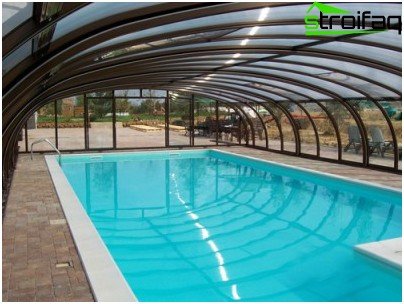
High Pavilion Example
Equipping the pavilion with elongated rails, it will be possible to move it beyond the boundaries of the pool. So the owners of the pavilion will always have a choice: whether to swim in a completely closed, open or half-open pool.
When choosing the height of the pavilion, it is necessary to decide what is specifically required from this protective coating. The design, which rises one meter from the surface, will prevent dust and debris from entering the water. To swim in the pool, you will need to move the section and enjoy clean warm water. The low height of the pavilion does not block the view. The average height allows you to enter the pool through a special door, which is usually installed in the end part.
Protective coatings of large height are also equipped with doors, however, compared with the previous version, they allow free movement along the sides of the pool, and also allow you to install chairs, tables, sun loungers inside the pavilion.
Form and types of structures
The asymmetric pavilion is a stationary swimming room, which has one high side wall. With front sliding panels.
Pavilions for a circular spherical pool consist of a stable dome-shaped structure made of mirror stainless steel. Overlap for a circular pool is made of double polycarbonate with a thickness of four millimeters (with a width of seven meters to eight millimeters).
The movable pool pavilion as standard consists of four sections. On request, the number of sections can be increased. For the transportation of sections using a roller shutter system with guide tires that do not require maintenance.
Arc arches of the pavilions are made of mirror stainless steel. The maximum size of the intermediate step can be 1.05 meters. All movable sections have at least 3 supporting arc profiles. The roofing sheet has a fixed width. Section length depends on floor length.
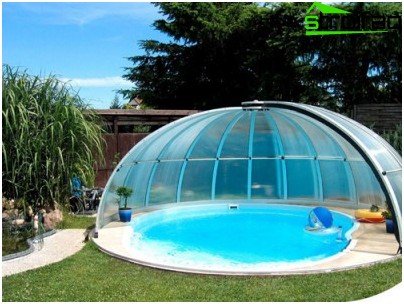
Round Pavilion
DIY pavilion construction
The construction of the pavilion is quite expensive. Therefore, many have the desire to build a pavilion for the pool with their own hands. In this case, some recommendations should be taken into account:
The pavilion must be installed on a special base, the width and length of which should be five to seven centimeters more than the expected dimensions of the protective structure being erected.
Even if polycarbonate and aluminum profiles are used to make the pavilion, the total weight of the structure can reach five tons. Therefore, the thickness of the concrete base should be at least 50-60 centimeters. The use of double reinforced concrete with a mesh size of 20×20 centimeters is recommended..
To build pavilions for pools with your own hands, taking into account the fact that the width of the base should be determined by the guide tires. Usually it is not more than fifty centimeters for a pavilion of 5 sections and not more than thirty-eight centimeters for the construction of a four-section pavilion.
When arranging the foundation, it must be borne in mind that it is not enough just to lay paving stones or stone slabs on gravel or sand. It is better to cover the concrete base with tiles or porcelain tiles, this will protect the concrete from moisture, and also hide its irregularities.
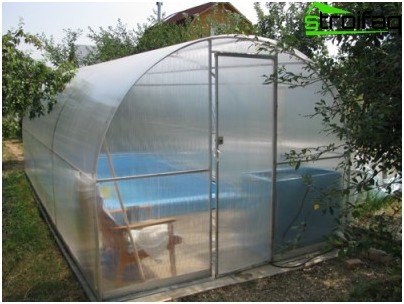
Pool pavilion built without specialist intervention
It is recommended to lay galvanized iron sheet bent between plastic and polycarbonate..
In addition, special attention must be paid to the reliability of the sealing of polycarbonate honeycombs. This is usually done with a special tape or colorless silicone sealant with antifungal agents..
Polycarbonate is attached to the profile with self-tapping screws. It is recommended to put washers made of stainless metals, for example, galvanized iron, under the hats of self-tapping screws. The size of the washers may be, for example, 1.5 x 1.5 centimeters. Then the mounting location is covered with sealant. This is done in order to avoid damage to the polycarbonate at the attachment point..
Pavilion Care
Caring for the pavilion is quite simple and does not require much effort. By using a special coating of polycarbonate plates, stains and stains are prevented. In winter, the construction needs systematic attention – it is necessary to clean snow from the roof of the pavilion from time to time.


